Input interpretation

phosphorus trichloride
Chemical names and formulas
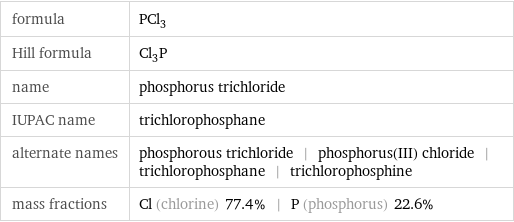
formula | PCl_3 Hill formula | Cl_3P name | phosphorus trichloride IUPAC name | trichlorophosphane alternate names | phosphorous trichloride | phosphorus(III) chloride | trichlorophosphane | trichlorophosphine mass fractions | Cl (chlorine) 77.4% | P (phosphorus) 22.6%
Lewis structure

Draw the Lewis structure of phosphorus trichloride. Start by drawing the overall structure of the molecule: Count the total valence electrons of the chlorine (n_Cl, val = 7) and phosphorus (n_P, val = 5) atoms: 3 n_Cl, val + n_P, val = 26 Calculate the number of electrons needed to completely fill the valence shells for chlorine (n_Cl, full = 8) and phosphorus (n_P, full = 8): 3 n_Cl, full + n_P, full = 32 Subtracting these two numbers shows that 32 - 26 = 6 bonding electrons are needed. Each bond has two electrons, so the above diagram has all the necessary bonds. There are 3 bonds and hence 6 bonding electrons in the diagram. Lastly, fill in the remaining unbonded electrons on each atom. In total, there remain 26 - 6 = 20 electrons left to draw: Answer: | |
3D structure

3D structure
Basic properties

molar mass | 137.3 g/mol phase | liquid (at STP) melting point | -112 °C boiling point | 76 °C density | 1.574 g/cm^3 solubility in water | decomposes
Units

Liquid properties (at STP)
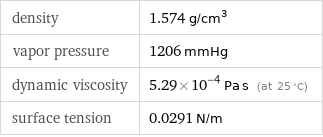
density | 1.574 g/cm^3 vapor pressure | 1206 mmHg dynamic viscosity | 5.29×10^-4 Pa s (at 25 °C) surface tension | 0.0291 N/m
Units

Thermodynamic properties
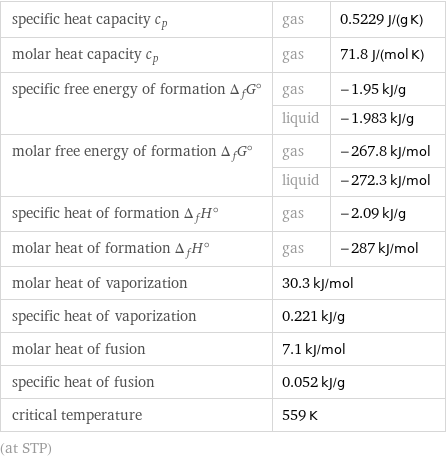
specific heat capacity c_p | gas | 0.5229 J/(g K) molar heat capacity c_p | gas | 71.8 J/(mol K) specific free energy of formation Δ_fG° | gas | -1.95 kJ/g | liquid | -1.983 kJ/g molar free energy of formation Δ_fG° | gas | -267.8 kJ/mol | liquid | -272.3 kJ/mol specific heat of formation Δ_fH° | gas | -2.09 kJ/g molar heat of formation Δ_fH° | gas | -287 kJ/mol molar heat of vaporization | 30.3 kJ/mol | specific heat of vaporization | 0.221 kJ/g | molar heat of fusion | 7.1 kJ/mol | specific heat of fusion | 0.052 kJ/g | critical temperature | 559 K | (at STP)
Chemical identifiers
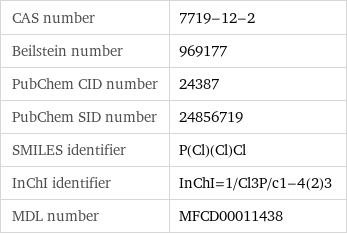
CAS number | 7719-12-2 Beilstein number | 969177 PubChem CID number | 24387 PubChem SID number | 24856719 SMILES identifier | P(Cl)(Cl)Cl InChI identifier | InChI=1/Cl3P/c1-4(2)3 MDL number | MFCD00011438
NFPA label

NFPA label
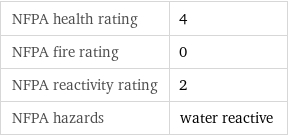
NFPA health rating | 4 NFPA fire rating | 0 NFPA reactivity rating | 2 NFPA hazards | water reactive
Toxicity properties

lethal dosage | 550 mg/kg (oral dose for rats) short-term exposure limit | 3 mg/m^3 threshold limit value | 0.2 ppmv

probable lethal dose for man | 600 mL (milliliters) long-term exposure limit | 1.5 mg/m^3 (over 8 hours) RTECS classes | other